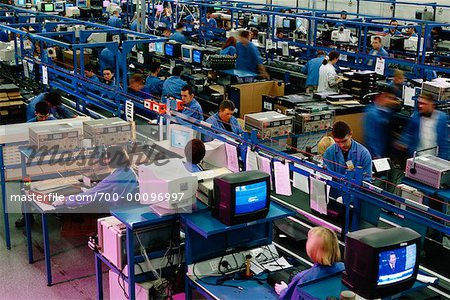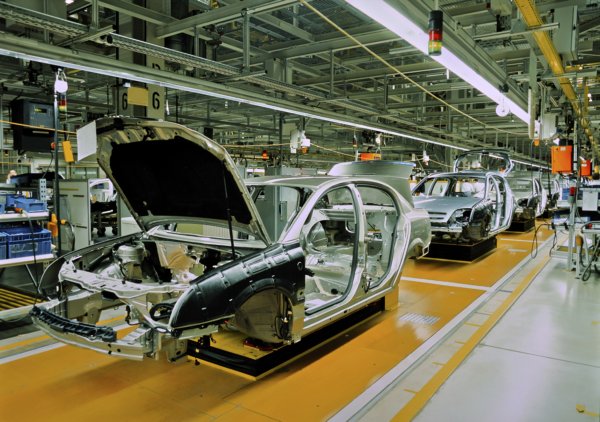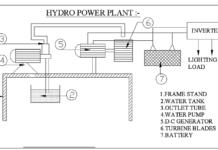COMPUTERS IN MANUFACTURING INDUSTRIES
Factors governing increased productivity, more accuracy, greater flexibility of shapes, and reduced manufacturing costs are forcing the manufacturing concerns to use computers in design, manufacturing and other allied functions of industrial activities. With an increase in the need for quality manufacturing along with the factors such as short lead time and short product lives and increasing consumer awareness as regards the quality of the product, it is becoming increasingly important for the manufacturers to initiate steps to achieve all these. The developments in microelectronics in the recent past have made higher computational ability available at a low cost. Therefore, it becomes imperative that manufacturing takes advantage of the availability of low cost and also using yet more powerful computers. Computers have been in use in manufacturing industries since 1960. Initially they were in use only in supportive functions such as inventory control purchase accounting, etc. In to day’s time, computer applications have progressed considerably in all areas of design and manufacturing involving CAD and CAM. This however needs to be emphasized that all the benefits of CAD and CAM can be achieved only if these two important functions are effectively interfaced. This interfacing is known as CAD/CAM. It involves the flow of information in both the directions. With the result the parts and assemblies are designed keeping in view the limitations and capabilities of the processes and materials. Consequently, newer and superior products can be produced more quickly and at lower costs.
Today, computers are not only used in manufacturing but they play also an important role in all manufacturing related activities such as business or financial management, factory level production management, CIM technologies, CAD, feature and solid modelling, and CAM, manufacturing information, manufacturing system. The important sub-activities of industrial environment have been identified to support with the use of computer in the manufacturing industries. These are given as under:
1. Business or Financial Management
1. Costing
2. Sales and Marketing
3. Purchase Order Control
4. Vendors
5. Subcontracting
6. Personnel.
2. Factory Level Production management
1. Planning
2. Production Management
3. Manufacturing production scheduling (MPS)
4. Material requirement planning (MRP)
5. Just in time (JIT)
6. Bill of Materials
7. Capacity Planning
8. Inventory Control.
3. CIM Technologies
1. Computer Networks
2. System Design and Analysis
3. Distributed Processing
4. Database Management Manufacturing
5. Modelling and Simulation
6. Expert Systems
7. Quality Engineering.
4. Computer Aided Design (CAD)
This area is also known Feature and Solid Modelling
1. Variational and Parametric
2. Modelling
3. Computer Graphics
4. Graphic Standards
5. Inter-graphics exchange specification (IGES)
6. Data exchange file (DXF)
7. Manufacturing Robot Programming
8. Design Analyses Tools
9. Programming
10. Finite element modelling (FEM)
11. Finite element analysis (FEA)
12. Simulation
13. Mechanisms
14. Test and Analysis
15. Design Tools Mechanical
16. Hydraulic, Electronics, etc.
5. Computer Aided Manufacturing (CAM)
This involves activities related to manufacturing information and manufacturing system which are given as under— Manufacturing Information
1. Generation
2. Process Planning
3. Production Planning
4. Computer numerical control (CNC) part Programming
5. Robot Programming
6. Coordinate measuring machine (CMM) Programming.
Manufacturing System
1. Production Activity
2. Machining
3. Assembly
4. Material Handling
5. Storage
6. Production Control
7. Loading
8. Scheduling
9. Balancing
10. Capacity Planning
11. Quality Control.
One of the most important components for getting various benefits associated with computer applications in manufacturing is the common databases associated with all aspects of manufacturing. In fact, all the modules in the CAM would actually be sharing the database created in any module. Any module would be able to modify the data as required for that particular application. This approach reduces the work involved in maintaining the product database and at the same time includes the latest modifications for any aspect related to manufacturing. In contrast to the common database approach, it is possible that sometimes individual modules in the production aspects may be taken from different vendors. In this case care need to be taken that information is properly transmitted between the modules and the data updating in all the modules takes place properly and at the right time. Some of above mentioned manufacturing activities are controlled by computers. These activities are commonly identified using the following terms.
1. Computer Aided Design (CAD)
2. Computer Aided Engineering (CAE)
3. Computer Aided Design And Drafting (CADD)
4. Computer Aided Process Planning (CAPP)
5. Computer Aided Tool Design (CATD)
6. Computer Aided Manufacturing (CAM)
7. Computer Aided Numerical Control (NC) Part Programming
8. Computer Aided Scheduling
9. Computer Aided Material Requirement Planning, etc.
10. Flexible Manufacturing System (FMS)
11. Group Technology (GT)
12. Computer aided Testing (CAT).
Reference Introduction to basic Manufacturing Processes and Workshop Technology by Rajender Singh.
For engineering project visit this page regularly for know more things related project ideas. Click here to see Ideas of Projects.













